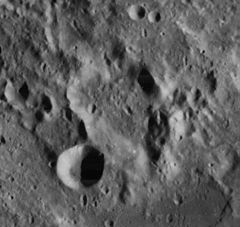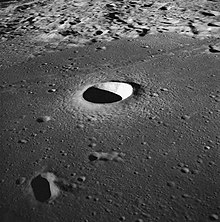Hypatia (crater)
Hypatia (crater)
| This is the current revision of this page, as edited by Jstuby(talk | contribs) at 01:31, 6 April 2018 (new section on Rimae, expand text). The present address (URL) is a permanent link to this version. |
Jump to navigation
Jump to search
 Lunar Orbiter 4 image | |
| Coordinates | 4°18′S 22°36′E / 4.3°S 22.6°E / -4.3; 22.6Coordinates: 4°18′S 22°36′E / 4.3°S 22.6°E / -4.3; 22.6 |
|---|---|
| Diameter | 41 × 28 km |
| Depth | 1.4 km |
| Colongitude | 338° at sunrise |
| Eponym | Hypatia of Alexandria |
Hypatia is a lunar impact crater that lies along the northwest edge of Sinus Asperitatis, a bay on the southwest edge of Mare Tranquillitatis. The nearest crater with an eponym is Alfraganus to the west-southwest. However, farther to the south-southeast, across the lunar mare, is the prominent crater Theophilus.
Hypatia is an asymmetrical formation with a rugged, irregular outer rim that is cut through by narrow clefts in several locations. It is generally longer along an axis running to the north-northwest, with the widest outward bulge occurring on the west side at the northern end. It resembles a merger of several crater formations that have gained a common interior floor. Attached to the exterior rim along the southwest is the satellite crater Hypatia A, a more symmetrical, bowl-shaped crater.

Moltke crater in the center, with Rimae Hypatia behind it (Apollo 10 photo)

Oblique view of Hypatia from Apollo 16
Rimae Hypatia[edit]
About 70 kilometers to the north of Hypatia is a system of linear rilles designated Rimae Hypatia. This runs for a length of about 180 kilometers across the Mare Tranquillitatis, and generally follows a course to the south-southeast. The part of the rilles close to the crater Moltke was informally called U.S. 1 by the Apollo 10 and Apollo 11 crews.
Satellite craters[edit]
By convention these features are identified on lunar maps by placing the letter on the side of the crater midpoint that is closest to Hypatia.
| Hypatia | Latitude | Longitude | Diameter |
|---|---|---|---|
| A | 4.9° S | 22.2° E | 16 km |
| B | 4.6° S | 21.3° E | 5 km |
| C | 0.9° S | 20.8° E | 15 km |
| D | 3.1° S | 22.7° E | 6 km |
| E | 0.3° S | 20.4° E | 6 km |
| F | 4.1° S | 21.5° E | 8 km |
| G | 2.7° S | 23.0° E | 5 km |
| H | 4.5° S | 24.1° E | 5 km |
| M | 5.3° S | 23.4° E | 28 km |
| R | 1.9° S | 21.2° E | 4 km |
References[edit]
.mw-parser-output .refbegin{font-size:90%;margin-bottom:0.5em}.mw-parser-output .refbegin-hanging-indents>ul{list-style-type:none;margin-left:0}.mw-parser-output .refbegin-hanging-indents>ul>li,.mw-parser-output .refbegin-hanging-indents>dl>dd{margin-left:0;padding-left:3.2em;text-indent:-3.2em;list-style:none}.mw-parser-output .refbegin-100{font-size:100%}
Andersson, L. E.; Whitaker, E. A. (1982). NASA Catalogue of Lunar Nomenclature. NASA RP-1097..mw-parser-output cite.citation{font-style:inherit}.mw-parser-output q{quotes:"""""""'""'"}.mw-parser-output code.cs1-code{color:inherit;background:inherit;border:inherit;padding:inherit}.mw-parser-output .cs1-lock-free a{background:url("//upload.wikimedia.org/wikipedia/commons/thumb/6/65/Lock-green.svg/9px-Lock-green.svg.png")no-repeat;background-position:right .1em center}.mw-parser-output .cs1-lock-limited a,.mw-parser-output .cs1-lock-registration a{background:url("//upload.wikimedia.org/wikipedia/commons/thumb/d/d6/Lock-gray-alt-2.svg/9px-Lock-gray-alt-2.svg.png")no-repeat;background-position:right .1em center}.mw-parser-output .cs1-lock-subscription a{background:url("//upload.wikimedia.org/wikipedia/commons/thumb/a/aa/Lock-red-alt-2.svg/9px-Lock-red-alt-2.svg.png")no-repeat;background-position:right .1em center}.mw-parser-output .cs1-subscription,.mw-parser-output .cs1-registration{color:#555}.mw-parser-output .cs1-subscription span,.mw-parser-output .cs1-registration span{border-bottom:1px dotted;cursor:help}.mw-parser-output .cs1-hidden-error{display:none;font-size:100%}.mw-parser-output .cs1-visible-error{font-size:100%}.mw-parser-output .cs1-subscription,.mw-parser-output .cs1-registration,.mw-parser-output .cs1-format{font-size:95%}.mw-parser-output .cs1-kern-left,.mw-parser-output .cs1-kern-wl-left{padding-left:0.2em}.mw-parser-output .cs1-kern-right,.mw-parser-output .cs1-kern-wl-right{padding-right:0.2em}
Blue, Jennifer (July 25, 2007). "Gazetteer of Planetary Nomenclature". USGS. Retrieved 2007-08-05.
Bussey, B.; Spudis, P. (2004). The Clementine Atlas of the Moon. New York: Cambridge University Press. ISBN 978-0-521-81528-4.
Cocks, Elijah E.; Cocks, Josiah C. (1995). Who's Who on the Moon: A Biographical Dictionary of Lunar Nomenclature. Tudor Publishers. ISBN 978-0-936389-27-1.
McDowell, Jonathan (July 15, 2007). "Lunar Nomenclature". Jonathan's Space Report. Retrieved 2007-10-24.
Menzel, D. H.; Minnaert, M.; Levin, B.; Dollfus, A.; Bell, B. (1971). "Report on Lunar Nomenclature by the Working Group of Commission 17 of the IAU". Space Science Reviews. 12 (2): 136–186. Bibcode:1971SSRv...12..136M. doi:10.1007/BF00171763.
Moore, Patrick (2001). On the Moon. Sterling Publishing Co. ISBN 978-0-304-35469-6.
Price, Fred W. (1988). The Moon Observer's Handbook. Cambridge University Press. ISBN 978-0-521-33500-3.
Rükl, Antonín (1990). Atlas of the Moon. Kalmbach Books. ISBN 978-0-913135-17-4.
Webb, Rev. T. W. (1962). Celestial Objects for Common Telescopes (6th revised ed.). Dover. ISBN 978-0-486-20917-3.
Whitaker, Ewen A. (1999). Mapping and Naming the Moon. Cambridge University Press. ISBN 978-0-521-62248-6.
Wlasuk, Peter T. (2000). Observing the Moon. Springer. ISBN 978-1-85233-193-1.
| Wikimedia Commons has media related to Hypatia (crater). |
Categories:
- LQ20 quadrangle
- Impact craters on the Moon
(window.RLQ=window.RLQ||).push(function(){mw.config.set({"wgPageParseReport":{"limitreport":{"cputime":"0.228","walltime":"0.281","ppvisitednodes":{"value":731,"limit":1000000},"ppgeneratednodes":{"value":0,"limit":1500000},"postexpandincludesize":{"value":29628,"limit":2097152},"templateargumentsize":{"value":7566,"limit":2097152},"expansiondepth":{"value":10,"limit":40},"expensivefunctioncount":{"value":2,"limit":500},"unstrip-depth":{"value":0,"limit":20},"unstrip-size":{"value":19052,"limit":5000000},"entityaccesscount":{"value":3,"limit":400},"timingprofile":["100.00% 235.035 1 -total"," 39.48% 92.784 1 Template:Infobox_Lunar_crater"," 35.97% 84.553 9 Template:Cite_book"," 33.15% 77.919 1 Template:Infobox"," 13.11% 30.822 1 Template:Coord"," 6.88% 16.160 1 Template:Cite_journal"," 6.83% 16.044 1 Template:Commonscat"," 5.43% 12.762 1 Template:Refbegin"," 4.97% 11.683 1 Template:Commons"," 4.43% 10.407 2 Template:Cite_web"]},"scribunto":{"limitreport-timeusage":{"value":"0.131","limit":"10.000"},"limitreport-memusage":{"value":5203813,"limit":52428800}},"cachereport":{"origin":"mw1324","timestamp":"20181014055038","ttl":1900800,"transientcontent":false}}});mw.config.set({"wgBackendResponseTime":133,"wgHostname":"mw1238"});});

 Clash Royale CLAN TAG
Clash Royale CLAN TAG